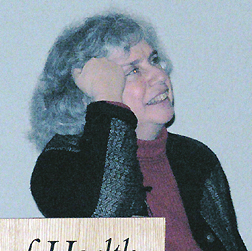
| T H E N I H C A T A L Y S T | M A R C H – A P R I L 2008 |
|
|
|
Anita
B. Roberts Lecture Series: Distinguished Women Scientists at NIH
|
by Gail Seabold |
 |
|
Susan
Gottesman
|
Susan Gottesman, co-chief of NCI’s Laboratory of Molecular Biology and chief of its Biochemical Genetics Section, presented the fourth lecture in the "Anita B. Roberts Lecture Series: Distinguished Women Scientists at NIH" on March 4.
Gottesman’s seminar, entitled "Stress Adaptation via Regulatory RNAs," focused on her recent work examining the role of small noncoding RNAs in regulating translation and messenger RNA stability. Her laboratory is interested in novel mechanisms for gene regulation and how these mechanisms contribute to global control circuits in Escherichia coli.
Conducting a genome-wide collaborative study, Gottesman identified 17 novel small RNAs and six new short mRNAs. Study of the function of these new small RNAs is ongoing, but many of them appear to be involved in translational regulation.
Another genome-wide search identified small RNAs that bind to the RNA chaperone Hfq, a protein that facilitates the interaction of small RNAs with messenger RNA. By base-pairing with messenger RNA, small RNAs can influence the translation of messenger RNA in a positive or negative manner, depending on the environment of the cell. Gottesman’s work suggests that small RNAs are important components of regulatory circuits and play a role in regulating stress responses to conditions such as low iron or the accumulation of toxic glucose phosphate.
For example, small RNAs can limit the production of nonessential iron-binding proteins, making iron more available to essential proteins, and cause the degradation of mRNA for the glucose transporter of the phosphotransferase system, thereby reducing the uptake of glucose and production of glucose phosphate.
Gottesman’s collaborations with other NIH investigators include the identification with Gisela Storz, NICHD, of some small noncoding RNAs in bacteria and with Michael Maurizi and Sue Wickner, both of NCI, on previous work that focused on the role of energy-dependent proteases in regulation of the degradation of abnormal and misfolded proteins, as well as their involvement in setting critical levels for regulatory proteins. This work led to Gottesman’s election to the American Academy of Microbiology, the National Academy of Sciences, and the American Academy of Arts and Sciences.
Gottesman
has also served as an editor of the Journal of Bacteriology, Genetics,
and Annual Review of Microbiology and as an editorial board member of
Genes & Development and Molecular Microbiology. She has had
leadership positions in the ASM, ASBMB, Genetics Society, and AAAS and is currently
on the NAS council. Among her many awards are an NIH Director’s Award and
NIH Merit Award.
![]()
| STARRING ROLES | THE ROBERTS LEGACY |
| Susan
Gottesman grew up on Long Island and became interested in microbiology after
reading Microbe Hunters by Paul de Kruif, a "historical fiction"
about such early microbiologists as Antonie van Leeuwenhoek and Louis Pasteur.
Gottesman received her B.A. in biochemical sciences from Radcliffe College
(Cambridge, Mass.), magna cum laude, and her Ph.D. in microbiology and molecular
genetics from the Graduate School of Arts and Sciences, Harvard University,
Cambridge. She came to NIH in 1971 to pursue postdoctoral training with
Max Gottesman (formerly at NCI, now at Columbia University), then went back
to Boston as a research associate in the MIT laboratory of David Botstein,
and returned to NIH in 1976 as a senior investigator in the Laboratory
of Molecular Biology, NCI, where she continues today. She is married
to Michael
Gottesman, deputy director for intramural research, and they have two
children and two granddaughters.
|
The
"Anita B. Roberts Lecture Series: Distinguished Women Scientists
at NIH" honors the memory of its namesake. who was chief of the Laboratory
of Cell Regulation and Carcinogenesis at NCI from 1995 until her death
May 26, 2006. A research leader at NIH for 30 years, Roberts was
a pioneer in the field of carcinogenesis, autoimmune disease, and wound
healing, with special contributions to current knowledge of transforming
growth factor–b.
She was among the top 50 most-cited authors for her published work from
1982 to 2002 (see "The
Shining Legacy of Anita Roberts," The NIH Catalyst, Sept.–Oct.
2007).
|